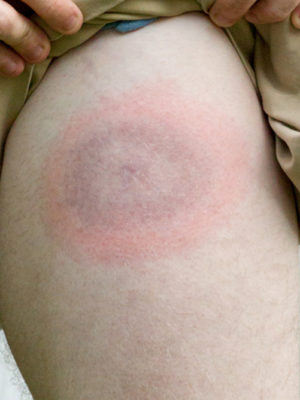
This is the tick-bite rash to look for, signaling the probable presence of Lyme disease. / iStock photo.
THOSE NASTY Lyme disease–carrying blacklegged ticks can crawl up the inside of pant legs, or up the outside and then in via the waistband; can be carried indoors on clothing; and appear to be increasing in the DMV area.
Although more than 30,000 cases of Lyme disease are reported annually nationwide, studies suggest the number might be closer to 300,000, according to the national Centers for Disease Control.
Locally, Maryland has the highest infection rate of Lyme, about 20 per 100,000 people, followed by Virginia at 13.1 and DC at 11.6—compared with the hardest-hit state, Pennsylvania, with 57.4 infections per 100,000—according to the most recent confirmed data from 2015.
(In estimates for 2016, rates for Virginia and DC went down slightly, while those for Maryland rose slightly, to 21.2, and for Pennsylvania, to 70.3. Tick-borne illness accounted for more than 75% of vector-borne disease reports in the U.S. in 2016.)
So this may be the summer to begin taking more anti-tick measures. Spray the insecticide (as opposed to insect repellent) permethrin on clothing, and repeat after every one or two washes. A local tree expert gives Repel to his crew but warns that “a little does not go a long way”—so spray heavily.
What might be easier over time is purchasing pants pre-treated with permethrin, on which effects last through dozens of washings.
In conjunction with insecticides, apply Environmental Protection Agency (EPA)-registered insect repellents containing DEET, picaridin and lemon eucalyptus oil directly on the body.
After walking in grass or any vegetation not closely trimmed, take a hot shower within two hours of being outdoors. Although the nymph or juvenile tick that most often transmits Lyme disease can be hard to spot “with bodies as small as a freckle or the tip of a pencil,” check your clothes and body. Wash clothes in hot water; before or instead of washing, dry for 10 minutes in a hot dryer. On the body, ticks love warm, moist areas like armpits, hair and especially groin areas.
Outdoors, remove brush and woodpiles, trim low-hanging vegetation, cut grass to the edge of wooded areas, and set up play areas on lawns rather than in wooded areas. And because dogs can bring Lyme-infected ticks indoors, collars or anti-tick chemicals are recommended for then as well.
If you see a mouse or signs of mice indoors, take immediate action. An individual mouse can carry up to 100 ticks at a time and infect up to 95% of them with Lyme.
And protect predators of the white-footed mice, crucial to the larval stage of the life cycle of Lyme-carrying ticks and considered primary vectors of Lyme disease. As many as 90% of white-footed mice carry the Lyme bacterium, and an individual mouse can carry up to 100 ticks at a time. At the next stage, the nymphs are most dangerous to humans, and adult ticks live and mate on deer, which are responsible for spreading the larvae.
Be especially kind to neighborhood foxes. When predatory animals such as red foxes proliferate, prey animals like mice show decreased movement and increased hiding behavior: “The mice are too busy hiding from foxes to end up as tick food,” according to Arlington Patch.
People should feel especially responsible for protecting predatory animals because human impact on the environment has caused rising temperatures and earlier springs, providing more time for ticks to become active and boosting tick populations. Ticks do well in temperatures 40 degrees and above, and with moisture, from both rainy weather and standing water.
If you find a tick attached to your skin, remove it as soon as possible—within 24 to 36 hours, before the tick has the time to inject the Lyme bacteria—and save the tick. If you experience Lyme symptoms, such as fever and muscles aches, without the characteristic bull’s-eye shaped rash, showing the tick to medical professionals can help persuade them to begin antibiotic treatment.
Because blood tests to detect Lyme disease rely on the development of a measurable immune response, it can take 10 to 30 days before tests show a positive response. But sometimes symptoms alone are clear—and often severe—enough that doctors will begin treating right away.
—Mary Carpenter
Every Tuesday Mary Carpenter reports on the state of our well-being, taking on topics like medical marijuana, longevity, psychedelic therapy and strength training.

Apparently the bullseye rash occurs in less than he=alf the Lyme cases so don’t rely on that as an indicator of infection. Great info on permethrin – spray – and impregnated clothes – REI has them!